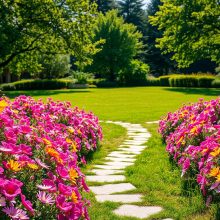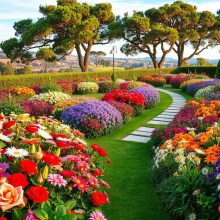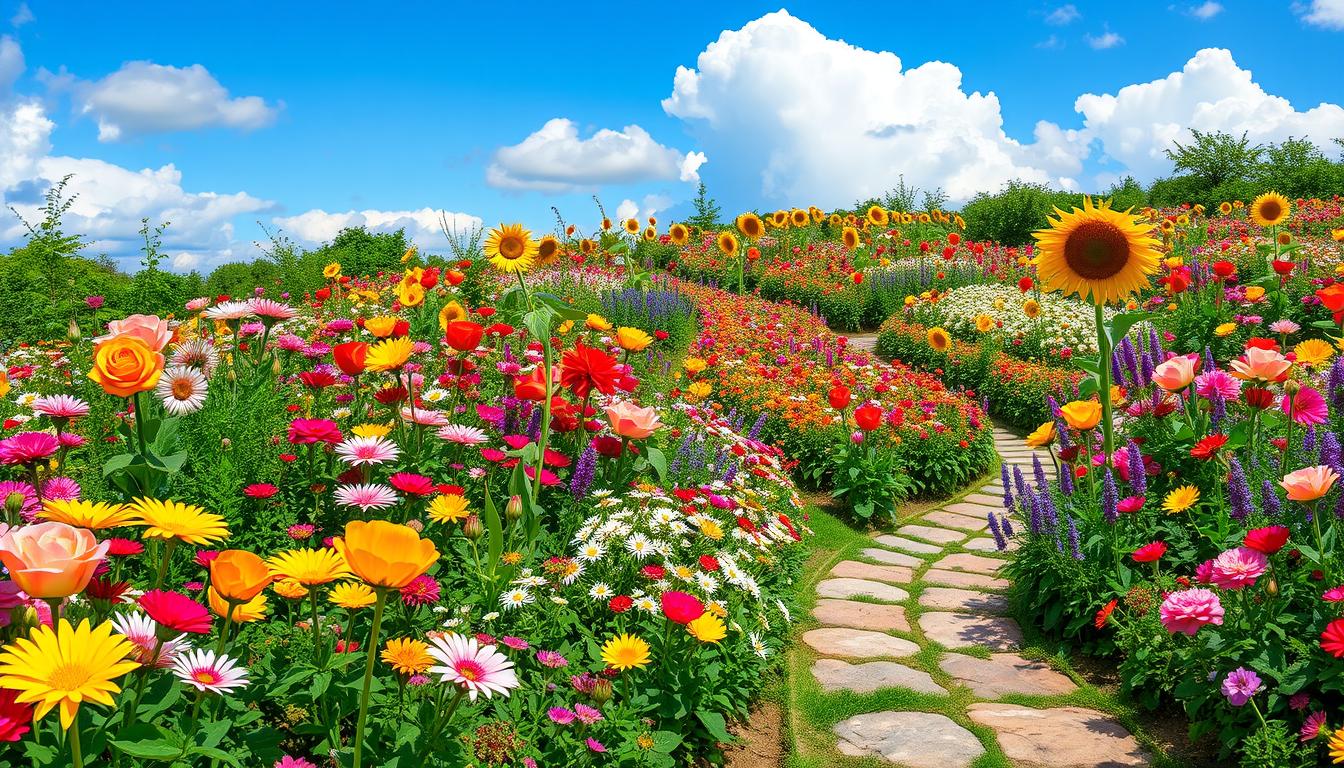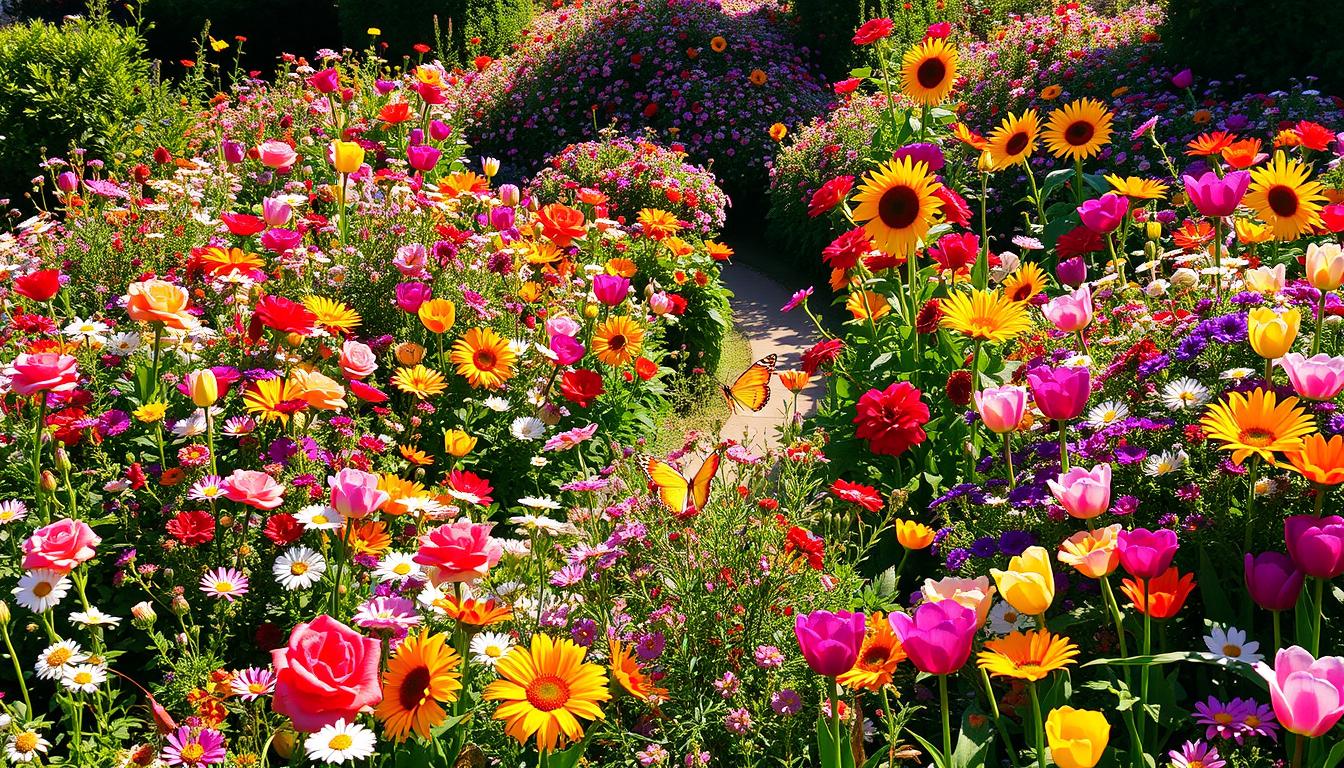Seasonal Flowers: Bring Nature’s Beauty Indoors
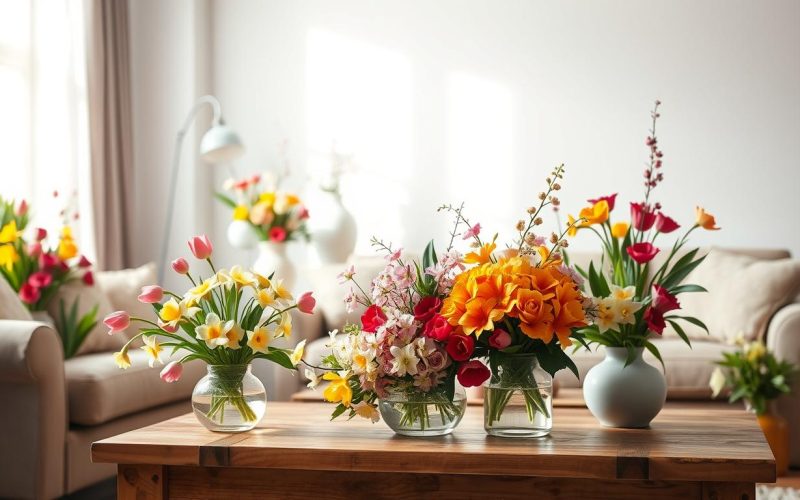
Nature’s colors can change our homes in amazing ways. Seasonal flowers add more than just beauty. They connect us to nature’s cycles, making our homes feel alive all year.
Picture stepping into a room with spring tulips or autumn chrysanthemums. These flowers make our homes feel like they’re part of nature’s ever-changing view. They lift our mood, improve our decor, and show us nature’s beauty.
Seasonal flowers can make any space feel new, whether it’s small or big. They bring color, texture, and a natural vibe that fake decorations can’t match.
Key Takeaways
- Seasonal flowers transform interior spaces dynamically
- Different flowers reflect nature’s changing cycles
- Indoor floral arrangements boost emotional well-being
- Seasonal blooms enhance home decor authentically
- Flowers connect indoor environments with natural rhythms
Understanding the Appeal of Seasonal Flowers
Seasonal flowers open a magical window into nature’s vibrant changes. They show the beauty of growth and renewal. Each flower tells a story of color and life.
What Makes Seasonal Flowers Unique?
Nature’s flowers change with the seasons, creating a stunning show all year. Seasonal flowers are special because they:
- Reflect the climate and conditions of each season
- Change color and texture with the seasons
- Connect us to nature’s ever-changing cycles
The Psychological Benefits of Flowers
Seasonal flowers do more than just look good. They can make us feel better. Studies show they lower stress, improve mood, and bring calm to our busy lives.
Celebrating Nature’s Cycles
Every flower captures a moment in time, showing the beauty of its season. From spring’s delicate blooms to autumn’s strong colors, they remind us of life’s constant renewal.
Popular Seasonal Flowers by Season
Nature’s flowers change with the seasons, showing off different colors and textures. Each time of year has its own special flowers. These can make homes, gardens, and events brighter.
Spring Blooms: A Fresh Start
Spring flowers mean new beginnings and hope. They come out after winter, adding bright colors to places inside and outside. Some of the most loved spring flowers are:
- Daffodils with their cheerful yellow petals
- Tulips in rainbow-like color variations
- Delicate cherry blossoms
- Fragrant lilacs
Summer Garden Favorites
Summer flowers are bold and bright, perfect for the warm weather. People love these flowers for their beauty:
- Sunflowers reaching tall towards the sky
- Zinnias in multiple vibrant shades
- Lavender with its soothing purple hues
- Dahlias showcasing intricate petal designs
Autumn Splendor: Colors that Warm the Heart
Autumn flowers show off the season’s warm colors. They fit perfectly with the earthy tones of fall:
- Chrysanthemums in deep oranges and browns
- Marigolds with their golden-yellow petals
- Sedum offering unique clustered blooms
- Asters providing delicate purple accents
Winter Wonders: Festive Floral Displays
Winter flowers add elegance and joy during the cold months. They make indoor spaces feel warmer:
- Poinsettias in classic red and white
- Amaryllis with dramatic trumpet-shaped flowers
- Christmas cacti offering soft pink blooms
- Paperwhite narcissus providing pure white elegance
Choosing Seasonal Flowers for Your Home
Seasonal flowers bring vibrant colors and natural beauty to your home. To create stunning arrangements, you need to know about color, flower selection, and display techniques.
Picking the right seasonal flowers is more than just choosing pretty ones. It’s about making choices that make your home look and feel better.
Tips for Arranging Seasonal Flowers
Here are some tips from professionals:
- Create visual contrast with complementary color combinations
- Mix flower heights for dynamic visual interest
- Balance delicate and bold flower types
- Consider the room’s existing color palette
The Best Vases for Different Flower Types
Choosing the right vase is key to great flower arrangements. Different flowers need different types of vases:
- Tall, narrow vases for long-stemmed flowers like lilies
- Wide-mouth containers for robust, full blooms
- Short, compact vases for dense arrangements
- Clear glass vases to showcase intricate stem structures
Florists say pick vases that match your flowers and home’s style. This thoughtful choice turns seasonal flowers into beautiful art.
Seasonal Flowers in Different Settings
Seasonal flowers make any event special. They add charm and elegance to weddings, corporate gatherings, and more. Using seasonal flowers can make any celebration brighter and more meaningful.
Seasonal Flowers for Weddings
Wedding planners use seasonal flowers to save money and create beauty. Spring weddings might have peonies and tulips. Autumn weddings feature dahlias and chrysanthemums. The floral calendar helps couples pick the best flowers for their big day.
- Spring: Soft pastels and delicate petals
- Summer: Bright, bold flower selections
- Autumn: Warm, rich color palettes
- Winter: Elegant whites and deep greens
Celebrations and Holidays: Thematic Arrangements
Seasonal flowers are key for holiday decorations. Christmas has poinsettias and holly. Fourth of July has red, white, and blue flowers. These arrangements connect guests to the holiday spirit.
Seasonal Flowers for Corporate Events
Corporate events look better with the right seasonal flowers. Conferences and launches can be enhanced with flowers that match the company’s brand and the season.
- Professional color coordination
- Subtle yet impactful design
- Reflecting company culture through flower choices
Sustainability and Seasonal Flowers
Choosing seasonal flowers is more than just picking pretty flowers. It’s a choice to help the environment and support local areas. Nature’s colors offer a chance to make choices that are good for our planet.
When we pick flowers, we should think about how they affect the planet. Flowers grown nearby cut down on pollution from long trips and energy use in greenhouses.
The Environmental Impact of Seasonal Sourcing
Seasonal flowers help protect our planet. By picking flowers grown close by, we:
- Lower emissions from travel
- Help local farms
- Use less energy in growing flowers
- Keep biodiversity in farming areas
Supporting Local Florists and Farmers
Local flower farmers are key to green farming. Buying flowers from them helps:
- Boost local economies
- Keep old farming ways alive
- Save our farming history
- Support green flower growing
Knowing how seasonal flowers help the planet, we can make better choices. These choices help our local communities and the planet.
Caring for Seasonal Flowers
Seasonal flowers add life and beauty to our homes. They change rooms with their natural charm. Knowing how to care for them helps them last longer.
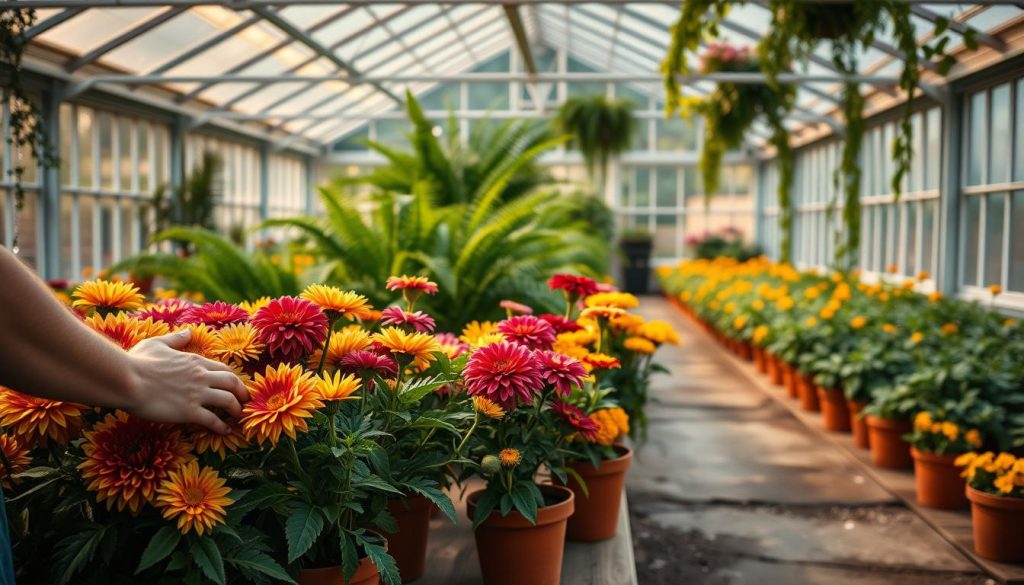
Starting with the right care is key. Each flower type has its own needs. This knowledge helps keep them looking great and lasting longer.
Proper Watering Techniques
Watering is crucial for keeping flowers alive. Here are some important tips:
- Use room temperature water for most flowers
- Change water every two to three days
- Remove leaves below the waterline to prevent bacterial growth
- Add a small amount of flower food to extend bloom life
Pruning and Maintenance for Longevity
Regular care keeps flowers looking fresh. Pruning is a big part of this:
- Trim stems at a 45-degree angle
- Remove dead or wilting petals
- Keep flowers away from direct sunlight
- Maintain consistent room temperature
Signs of Aging: When to Replace Flowers
Knowing when to replace flowers keeps your display looking good. Look out for these signs:
- Drooping or discolored petals
- Cloudy or foul-smelling water
- Soft or mushy stem bases
- Significant leaf yellowing
By following these care tips, you can enjoy your seasonal flowers for longer. They will stay fresh and beautiful.
Seasonal Flowers and Their Meanings
Flowers have their own language, telling stories with colors and petals. Each season’s flowers carry special meanings, linking us to nature and our feelings. Learning about these meanings shows us a world of traditions and personal stories.
Every season brings its own flowers, each with its own message. These messages are about emotions and traditions. Let’s dive into the beauty of nature’s language.
Meaning of Spring Flowers
- Daffodils symbolize new beginnings and rebirth
- Tulips represent perfect love and renewal
- Cherry blossoms signify the fragility of life and hope
Highlights of Summer Floral Symbolism
- Sunflowers represent happiness and loyalty
- Lavender symbolizes serenity and grace
- Roses communicate complex emotional messages
The Significance of Autumn Arrangements
- Chrysanthemums represent loyalty and honor
- Marigolds symbolize warmth and remembrance
- Dahlias express inner strength and creativity
Understanding Winter Flower Traditions
- Poinsettias represent holiday cheer
- Amaryllis symbolizes determination and beauty
- Hellebores represent hope during challenging times
Discovering the meanings of seasonal flowers lets us see nature’s beauty. Each flower has a story, connecting us to our feelings and traditions.
DIY Seasonal Flower Projects
Seasonal floristry lets you turn beautiful flowers into personal art. DIY projects connect you with nature’s cycles. They also help you make unique decorations that show off each season’s spirit.
Working with seasonal flowers is a great way to keep their beauty alive. It’s also a fun way to make lasting memories. These projects celebrate nature and offer a calming, creative outlet for flower lovers.
Making Your Own Bouquets
To make your own bouquets, you need some basic skills. First, pick fresh, seasonal flowers that match in color and texture.
- Choose a main flower for the bouquet’s center
- Pick flowers and greenery that go well together
- Trim stems with sharp scissors at an angle
- Arrange the flowers in a way that looks good
Flower Pressing for Art Projects
Flower pressing turns seasonal blooms into stunning art. It’s perfect for delicate flowers from any time of year.
- Pick fresh, flat flowers without water
- Put flowers between paper to absorb moisture
- Use a heavy book or press to flatten
- Keep pressed flowers in a dry, dark place
Seasonal Flower Wreaths: A Step-by-Step Guide
Making flower wreaths adds natural beauty to your home. These decorations show off the special qualities of each season’s flowers.
- Choose a wreath base (wire, foam, or grapevine)
- Gather flowers and leaves from the season
- Secure flowers with floral wire
- Make a design that looks good with different textures
DIY projects in seasonal floristry let you be creative and celebrate nature’s beauty. It’s a fun way to connect with the natural world.
The Role of Seasonal Flowers in Interior Design
Seasonal flowers bring life and color to our homes. They make our living spaces vibrant and dynamic. Designers and homeowners use them to make their homes beautiful and memorable.
To use seasonal flowers well, we need to think about color, texture, and room layout. They help us refresh and renew our homes all year round.
Color Schemes That Complement Seasonal Blooms
Choosing the right colors can make seasonal flowers stand out. Here are some tips to match flowers with your room’s colors:
- Match flower colors with existing room accent colors
- Create contrast by introducing complementary color tones
- Use neutral vases to highlight vibrant seasonal flowers
- Select flowers that echo the room’s dominant color palette
Incorporating Flowers into Different Décor Styles
Seasonal flowers can enhance any design style. They connect us to nature and add beauty to our spaces. Whether your style is minimalist, bohemian, or traditional, flowers can make it pop.
Enhancing Outdoor Spaces with Seasonal Flowers
Bring your home’s design outside by choosing the right flowers. Potted plants, hanging arrangements, and garden displays can make patios, balconies, and entryways beautiful.
Flower Festivals and Events Across the U.S.
The United States is filled with vibrant seasonal flowers at amazing festivals. These events celebrate nature’s beauty and show off the diversity of flowers across the country. They give visitors a chance to see unique flowers and bring people together through flower celebrations.
Looking at the nation’s floral calendar, you’ll find exciting festivals. These events highlight local flowers and offer cultural and educational experiences. They are perfect for flower lovers.
Major National Flower Festivals
- National Cherry Blossom Festival in Washington, D.C.
- Skagit Valley Tulip Festival in Washington State
- Epcot International Flower & Garden Festival in Florida
- Rose Parade in Pasadena, California
Local Celebrations to Experience
Regional flower festivals give a close look at local flower traditions. They range from small town parades to big garden shows. These events highlight the unique flowers of each area.
- Bluebonnet Trails in Texas Hill Country
- Lavender Festival in Oregon
- Sunflower Festivals in Kansas
- Lilac Festival in Rochester, New York
Going to these festivals lets you dive into the beauty of seasonal flowers. You can learn about local plants and make memories. Each festival offers a special view of the botanical diversity in the United States.
The Economic Impact of Seasonal Flowers
The flower industry is a lively and changing market with big economic chances. Seasonal flowers are key in growing the market and keeping customers interested across the United States.
The global cut flower market is getting bigger, thanks to seasonal demand. This demand opens up special economic chances for growers, sellers, and local areas. Knowing how seasonal flowers work helps businesses plan and customers make smart buys.
The Flower Industry: A Growing Market
Here are some important facts about the seasonal flower market:
- Market value is about $45 billion worldwide
- It grows by 5-7% each year
- More people want to buy flowers that are locally grown and in season
- New chances are coming up in growing flowers in a green and organic way
Seasonal Demand and Pricing Trends
Prices for seasonal flowers change a lot because of how much is available and when it blooms. Prices are affected by:
- Weather and how it affects crops
- High demand during holidays and special events
- What different areas can grow
- What kinds of flowers people like to buy
Local farmers and small flower producers are gaining from the growing love for seasonal flowers. This makes farming more sustainable and strong economically.
Innovative Uses for Seasonal Flowers
Seasonal flowers are more than just for bouquets. They bring nature’s beauty into many parts of our lives. By exploring new ways to use them, we see flowers in a fresh light.
Flowers are now used in creative ways, beyond just decorating. Artists and chefs are finding new uses for seasonal blooms. They’re using them in unexpected places and experiences.
Floral Arrangements Beyond Bouquets
Today, creative minds are finding new uses for seasonal flowers:
- Living wall installations with seasonal plants
- Floral sculptures for public areas
- Interactive flower art exhibits
- Sustainable buildings with living flowers
Edible Flowers: Cooking with Seasonal Beauty
Chefs are using edible flowers to add color and flavor to food. Flowers like nasturtiums, pansies, and marigolds make dishes special.
- Decorating salads with colorful petals
- Making floral desserts
- Creating botanical cocktails and teas
- Decorating cakes with flower arrangements
These new uses for seasonal flowers show how they can change our daily lives. They connect us closer to nature’s beauty.
Creating a Seasonal Flower Calendar
Making a floral calendar changes how people enjoy flowers. It lets them match their indoor and outdoor spaces with nature’s beauty. This way, they can enjoy the changing seasons through flowers.
Having a detailed seasonal flower calendar is key. It helps gardeners and flower fans get ready for each season’s flowers. This keeps them connected to nature’s beauty all year.
Planning Your Seasonal Flower Journey
Good seasonal flower planning means knowing a few things:
- When different flowers bloom best
- The local weather patterns
- Where to put flowers indoors and outdoors
- Choosing flowers that fit each season
Adjusting Indoor Flower Selections
Choosing indoor flowers needs thought all year. Update your floral calendar with the seasons. This keeps your home lively and interesting.
- Spring: Light, soft flowers like tulips and daffodils
- Summer: Bright, bold flowers like sunflowers and dahlias
- Autumn: Warm flowers like chrysanthemums and marigolds
- Winter: Elegant white amaryllis and festive poinsettias
A good plan for seasonal flowers brings life to your home. It makes your space change and grow, just like nature.
Challenges in Sourcing Seasonal Flowers
The world of seasonal flowers is facing big challenges due to climate changes. Global warming and unpredictable weather are changing how flowers grow. This makes it hard for both flower lovers and professional growers.
Getting flowers has become more complicated because of the environment. The old ways of knowing when flowers bloom are no longer reliable. Several factors are messing with how flowers grow naturally:
- Irregular temperature changes
- Longer droughts
- Unexpected frosts
- Changes in how much rain falls
Climate Change and Flower Availability
Farmers and flower experts are seeing big changes in growing flowers. Some places have shorter growing seasons, while others see changes in when and how flowers bloom. These changes affect how many and what kinds of flowers we can find.
Navigating Seasonal Variations
To deal with these issues, flower fans can take smart steps. Support local growers who know their area well. Look for flower types that can handle changing weather. And be ready for changes in what flowers are available.
- Learn about native flowers
- Check out local botanical gardens
- Try new flower types
- Keep up with local weather trends
Knowing about these challenges helps us appreciate the beauty and strength of seasonal flowers. They adapt to a world that’s always changing.
Seasonal Flowers in Popular Culture
Nature’s seasonal colors have always fascinated artists, writers, and designers. They turn seasonal flowers into symbols of beauty and feeling. These flowers tell stories of life’s changes on canvas and catwalk.
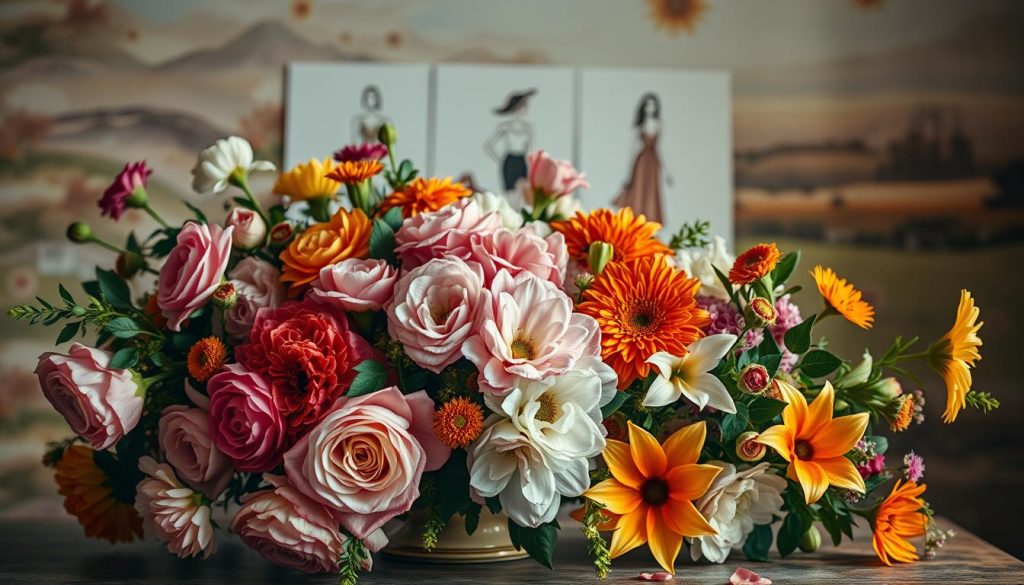
Seasonal flowers inspire many creative fields. Their fleeting beauty and yearly cycle offer deep meanings for art.
Florals in Art and Literature
Artists and writers see flowers as key storytelling tools. Georgia O’Keeffe turned flowers into symbols of natural beauty. Emily Dickinson wrote verses that celebrate the life cycle of plants.
- Romantic poets used flowers to express human feelings
- Impressionist painters showed flowers’ fleeting nature
- Today’s writers see flowers as symbols of personal growth
The Influence of Flowers in Fashion
Fashion designers often look to nature for ideas. Flowers guide color trends, prints, and fabrics, showing nature’s beauty.
- Spring fashion includes soft floral prints
- Summer fashion has bold, tropical flower designs
- Fall collections use deeper, richer flower colors
- Winter fashion features simple, sculptural flower motifs
The bond between flowers and creativity keeps growing. It shows how forever connected we are to nature’s beauty.
Conclusion: Embracing Seasonal Flowers Year-Round
Seasonal flowers are more than just decorations. They connect us to nature’s beauty, showing us the changing world of plants. By picking seasonal flowers, we bring nature’s colors into our homes, making our spaces change with the seasons.
Exploring seasonal flowers helps us value local ecosystems and eco-friendly choices. Choosing flowers that grow in our area helps local farmers and cuts down on carbon emissions. This way, we show we care about the planet as much as we care about beauty.
Seasonal flowers teach us about life’s cycles and how to live in harmony with nature. Whether it’s spring tulips or winter amaryllis, each flower has a story of growth and resilience. By embracing these stories, we connect with nature and make our homes more meaningful.
Final Thoughts on the Beauty of Seasonal Blooms
Seasonal flowers remind us that beauty is always changing. By welcoming these natural wonders, we make our spaces alive and in tune with the Earth’s rhythms.
Encouraging a Greener Lifestyle with Seasonal Choices
Let seasonal flowers inspire you to live greener. Start by choosing local flowers and supporting local florists. These small steps can make a big difference for our planet.
